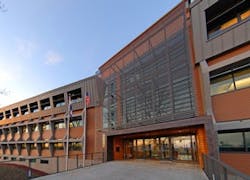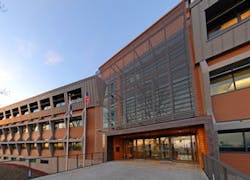McQuay® helps Lewis and Clark Administration Building
In the spirit of the explorers after whom it is named, the Lewis and Clark State Office Building in Jefferson City, Missouri, has charted new territory. The facility is one of only 16 buildings in the nation-and the first state office building nationwide-to receive a Platinum certification, the highest rating in the LEED-New Construction (NC) Version 2.1 program administered by the U.S. Green Building Council (USGBC). Innovative air conditioning components manufactured by McQuay® International - 24 custom configured Vision™ air handlers and two model WSC high-efficiency centrifugal chillers - contributed significantly to the achievement.
Building elements create design synergies
Commissioned in 2004, the Lewis and Clark Building provides 120,000 square feet of office space for Missouri’s Department of Natural Resources on a site overlooking the Missouri River.
Other important design features that save energy include:
- Ceiling- to-waist-level windows rather than the more common floor-to-ceiling;
- Operable windows that allow workers to bring in “free” fresh air when available;
- Photovoltaic panels on the roof that generate about 2.5 percent of needed energy;
- Chilled water for air conditioning that is generated at night and stored in a cistern under the building for use during the day.
Wherever possible, the energy-saving features of the building are visibly expressed to educate the public about green building strategies.
Energy costs are 60 percent lower than ASHRAE standard
Lesniewski says the Lewis and Clark Building design team aimed for gold-level certification, adding, “The fact that we achieved Platinum reflects the incredible team effort by the owner group and the entire design and construction team.” To achieve the Platinum rating, the building fulfilled 53 points. Fifteen of these - 28 percent of all points awarded - were in the Energy and Atmosphere (EA) category, which takes into account the integrated performance of the building’s envelope and its mechanical and electrical systems.
Of the 15 points earned in the EA category, 10 out of a possible 10 were earned for EA Credit 1-Optimize Energy Performance. In doing so, the design team had to demonstrate that the building required 60 percent less in energy cost than a comparably designed building that just met the requirements of ASHRAE Standard 90.1-2004.
Under-floor air distribution system
One of the design team’s key decisions was to choose an under-floor air distribution (UFAD) system. A UFAD system delivers air through floor-mounted diffusers in a plenum formed by a floor raised above the concrete slab. This produces a floor-to-ceiling air flow that takes advantage of the natural buoyancy produced by heat sources in the office; even cooled air is eventually pushed up. This results in relatively uniform air temperatures in the space where people actually work - from the floor to a height of about six feet.
McQuay® Vision™ air handlers are an essential part of the UFAD system. Custom-modular flexibility is the fundamental idea behind Vision air-handling units. It allows specifying engineers to size the unit’s cabinet on two-inch size increments for both height and width without limiting the component selections available to meet the requirements of the application. That allowed the Lewis and Clark design team to specify 24 air handlers of varying sizes with no need for custom-fabricated equipment.
Placing the air handlers around the building contributed to significant savings in duct work. McQuay Applications Manager Jay Eldridge says, “You can supply as much energy around a building using two-inch chilled water pipes as you get with 40-inch ducts.” Peter Rumsey, principal, Rumsey Engineers, Oakland, CA, whose company designed the HVAC systems, adds, “All those air handlers placed around the building mean reducing the fan energy loading, resulting in a pressure drop that is about one-third of what you find in the typical system.”
The efficiency of the Vision air handlers in the UFAD system ultimately reduces the load on all other components of the HVAC system - including the chillers. The design team specified two McQuay WSC high efficiency centrifugal chillers for their energy-efficient operation. The compressor unloads down to 10 percent of full load without hot gas bypass. Variable speed drives contribute to the chiller’s superior part load efficiency. In addition, the chillers won one point for EA Credit 4-ozone depletion potential-because they use HFC-134a refrigerant, which has no ozone depletion potential or phase-out schedule.
Although each component is designed for efficiency, it is the overall efficiency of the HVAC system integrated with green building design that delivered so many LEED-NC points - and so much in daily energy savings - in the Lewis and Clark building. Rumsey estimates that about 60 percent of the building’s overall efficiency is derived from the innovative design of the HVAC system, and about 40 percent from lighting and architectural considerations.
Discovering the benefits of green territory
With annual energy savings of about $90,000 over conventional buildings of similar size, the Lewis and Clark building carries on the tradition of its namesakes by exploring new horizons in sustainable building design.

